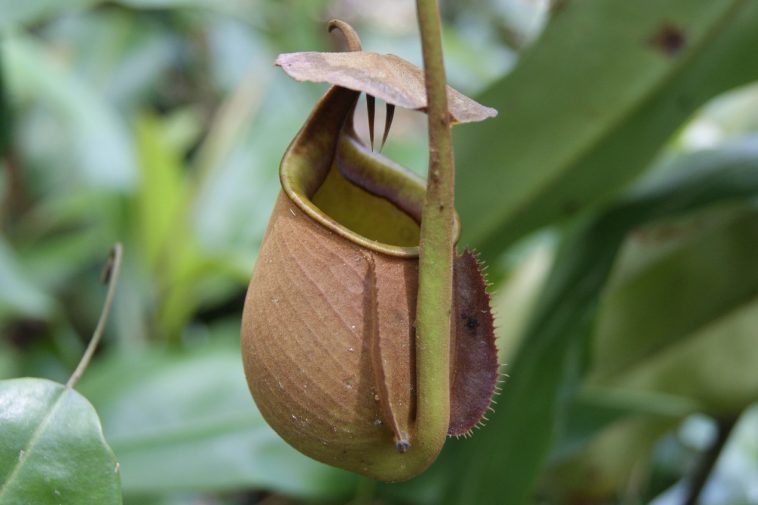[Originally published as Pitcher Plants: Evolved or Designed]
Carnivorous plants have fascinated humanity for centuries. Even Charles Darwin (Darwin, 1875) took time from reshaping the scientific landscape to write about these bizarre plants.
Pitcher plants are one of the more well-known variants of carnivorous plants. They come in a variety of sizes, styles, and colors and are somewhat popular as ornamental plants. According to current research, they have an interesting evolutionary history as well.
Pitcher plants trap their food using a hollow pitcher. Some species use color patterns on the pitcher to attract their insect prey (Schaefer and Ruxton, 2008). At the bottom of the pitcher is a pool of liquid composed of part water and part digestive enzymes. In some species, this liquid is also viscoelastic, making it harder for any unfortunate organism that ends up in the liquid to escape (Gaume and Forterre, 2007).
Captured prey is sometimes also kept from escaping the trap by utilizing a waxy coating on the sides of the pitcher (Moran and Clarke, 2010). The two means of escape prevention are rarely found together and tend to work better against different types of prey (Bonhomme et al, 2011). Once the prey is trapped, digestive enzymes go to work, breaking down the unfortunate organism and allowing the pitcher plant to uptake nutrients.
Trapping prey in this manner is unique to pitcher plants and, upon first glance, would appear to have evolved once. However, phylogenetic evidence points to multiple origins. Givnish (2015) claims at least six separate origins for pitfall-style traps, though he does not cite a source for his claim. Ellison and Gotelli (2001) list four separate origins for pitfall traps. Regardless of the exact number of origins of pitfall traps, the evolutionists claim they have originated multiple times and undergone convergent evolution to reach their current form (Thorogood et al, 2018).
The phylogenetic evidence for multiple independent origins of the pitfall traps comes from several phylogenetic studies in multiple groups of pitcher plants. Though different genes and segments of genes from different cellular compartments (nucleus, mitochondria, chloroplast) (Ellison et al, 2012) were used, the underlying method is the same.
- Genes of interest are sequenced, then run through a phylogenetics program.
- The program produces a phylogenetic tree based on the principle of homology.
Homologous sequences are those that share a similarity in their arrangement, not necessarily in function. According to various phylogenetic studies of these sequences (Schwallier et al, 2016, Biswal et al, 2018), pitcher plants have multiple origins and, in the case of Biswal et al, are more closely related to some non-carnivorous plants than they are to other carnivorous plants. We’ve written about phylogenetics before and do not find any phylogenetic evidence terribly compelling as an answer for origins. This is due to several underlying assumptions, including assuming evolution is true to prove evolution is true.
Importantly, while the focus with carnivorous plants is on their carnivorous features, they are still plants and have other typical plant features like roots, leaves, and flowers.
There are broad morphological divergences between the various pitcher plants. For example, Nepenthes flowers in inflorescences (Handayani, 2017). Sarraceniaceae flowers in single floral heads that tend to droop over toward the ground (Ellison et al, 2006). They differ in other morphological details as well. Their strongest claim to being related is the convergence of the pitchers. Otherwise, they are both functionally and genetically divergent.
What evolutionists tend to ignore is the impossibility of creating these structures from antecedents. They do not have an answer for how the structures developed. The best they could do was appeal to phylogenetics which does not work. Pitcher plants are best described by an appeal to the Creator, not evolution.
References:
Biswal DK, Debnath M, Konhar R, Yanthan S, Tandon P. 2018. Phylogeny and biogeography of carnivorous plant family Nepenthaceae with reference to the Indian pitcher plant Nepenthes khasiana reveals an Indian subcontinent origin of Nepenthes colonization in south east Asia during Miocene epoch. Front Ecol Evol.
Bonhomme V, Pelloux-Prayer H, Jousseline E, Forterre Y, Labat JJ, Gaume L. 2011. Slippery or sticky? Functional diversity in the trapping strategy of Nepenthes carnivorous plants. New Phytol. 191(2):545-554.
Darwin C. 1875. Insectivorous plants. London: John Murray.
Ellison AM, Gotelli NJ. 2001. Evolutionary ecology of carnivorous plants. Trends Ecol Evol. 16(11):623-629.
Ellison AM, Butler ED, Hicks EJ, Naczi RFC, Caile PJ, Bell CD, Davis CC. 2012. Phylogeny and biogeography of the carnivorous plant family Sarraceniaceae. PLoS One.
Ellison AM, Ne’eman G, Ne’eman R. 2006. Limits to reproductive success of Sarracenia purpurea (Sarraceniaceae). Am J. Bot. 93(11):1660-1666.
Gaume L, Forterre Y. 2007. A viscoelastic deadly fluid in carnivorous pitcher plants. PLoS One.
Givnish TJ. 2015. New evidence on the origin of carnivorous plants. Proc Natl Acad Sci U S A. 112(1):10-11.
Handayani T. 2017. Flower morphology, floral development and insect visitors to flowers of Nepenthes mirabilis. Biodiversitas. 18(4):1624-1631.
Moran JA, Clarke CM. 2010. The carnivorous syndrome in Nepenthes pitcher plants. Plant Signal Behav. 5(6):644-648.
Schaefer HM, Ruxton GD. 2008. Fatal attraction: carnivorous plants roll out the red carpet to lure insects. Biol Lett. 4(2):153-155.
Schwallier R, Raes N, de Boer HJ, Vos RA, van Vugt RR, Gravendeel B. 2016. Phylogenetic analysis of niche divergence reveals distinct evolutionary histories and climate change implications for tropical carnivorous pitcher plants. Divers Distrib. 22(1):97-110.
Thorogood CJ, Bauer U, Hiscock SJ. 2018. Convergent and divergent evolution in carnivorous pitcher plant traps. New Phytol. 217(3):1035-1041.







